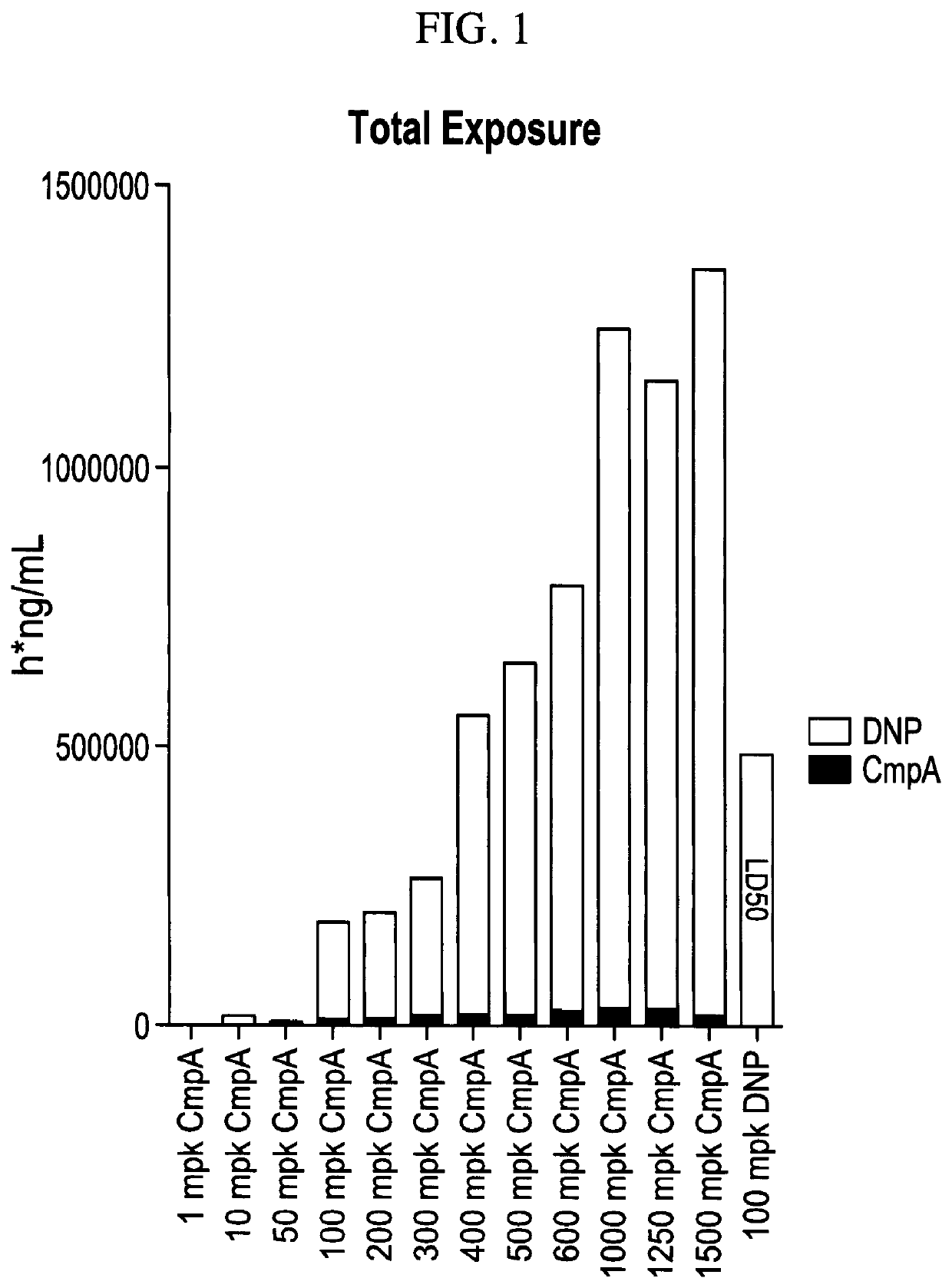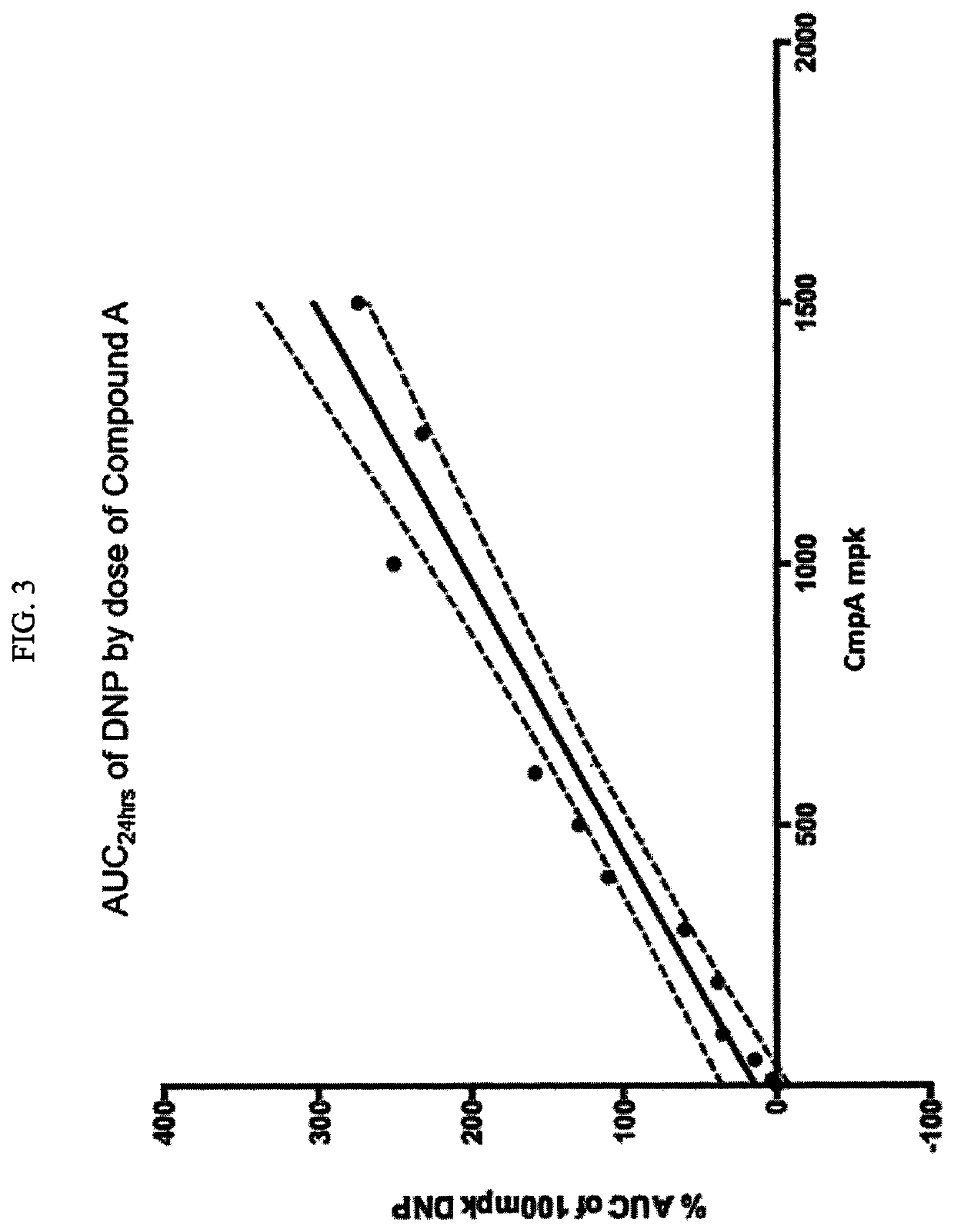Phenyl derivatives
a technology of phenyl derivatives and derivatives, applied in the field of phenyl derivatives, can solve the problems reducing the risk of dnp removal, and rapid energy consumption (the energy expenditure) without generation, and achieving the effect of reducing the risk of cardiovascular diseas
- Summary
- Abstract
- Description
- Claims
- Application Information
AI Technical Summary
Benefits of technology
Problems solved by technology
Method used
Image
Examples
example 1
Plasma Concentration of DNP and Compound A after DNP or Compound A Administration
[0151]Materials and Methods: 5-7 week old male C57BL / 6 mice weighing 18-20 g was obtained from Beijing Vital River Co., LTD. The animals were quarantined in polycarbonate cages and in an environmentally monitored, well-ventilated room maintained at a temperature of (22±+3° C.) and a relative humidity of 40%-80% in laminar flow rooms with 3 animals in each cage for 7 days before and during the study. Fluorescent lighting provided illumination approximately 12 hours per day. The bedding material was corn cob, which was changed once per week. Each animal was assigned an identification number. The mice had access to irradiation sterilized dry granule food (Beijing Keaoxieli Feed Co., Ltd., Beijing, China) and sterile drinking water ad libitum during the entire study period.
[0152]Based on the body weight, animals were randomly assigned (n=4) to respective groups using a computer-generated randomization proce...
example 2
Plasma Concentration of ALT, AST and ALP Liver Enzymes after Administering Compound A to Mice with Induced Fatty Liver Disease
[0157]Male C57BL / 6 mice were obtained from Beijing Vital River Co., LTD. The animals were quarantined in polycarbonate cages and in an environmentally monitored, well-ventilated room maintained at a temperature of (22±3° C.) and a relative humidity of 40%-80% in laminar flow rooms with 3 animals in each cage for 7 days before and during the study. Fluorescent lighting provided illumination approximately 12 hours per day. The mice had access to irradiation sterilized dry granule food (Beijing Keaoxieli Feed Co., Ltd., Beijing, China) and sterile drinking water ad libitum during the first week.
[0158]After acclimatizing, and throughout the study period, the food was exchanged for methionine / choline-deficient chow (MCD) to induce nonalcoholic Fatty Liver Disease (NAFLD) in the animals. After four weeks on MCD, the animals were divided into four groups (n=8) and a...
example 3
Oral Glucose Tolerance Test after Compound a Administration to Mice with Induced Fatty Liver Disease
[0161]Mice were treated as described in Example 2. Oral Glucose Tolerance Test (OGTT) was performed on all study animals after five weeks of Compound A treatment. The baseline (time 0) glucose level was measured after 16 hours fasting. Following oral administration of 2 g / kg glucose, the blood glucose levels were measured at 30, 60 and 120 minutes using Accu-Chek Performa System.
[0162]Results. Blood glucose levels were significantly lower 120 minutes after the glucose test in all three treatment groups (p<0.05 for 25 mg / kg and 100 mg / kg treatments, p<0.01 for 5 mg / kg treatment). See FIG. 6.
PUM
| Property | Measurement | Unit |
|---|---|---|
| temperature | aaaaa | aaaaa |
| temperature | aaaaa | aaaaa |
| time | aaaaa | aaaaa |
Abstract
Description
Claims
Application Information
 Login to View More
Login to View More - R&D
- Intellectual Property
- Life Sciences
- Materials
- Tech Scout
- Unparalleled Data Quality
- Higher Quality Content
- 60% Fewer Hallucinations
Browse by: Latest US Patents, China's latest patents, Technical Efficacy Thesaurus, Application Domain, Technology Topic, Popular Technical Reports.
© 2025 PatSnap. All rights reserved.Legal|Privacy policy|Modern Slavery Act Transparency Statement|Sitemap|About US| Contact US: help@patsnap.com



